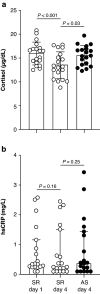Severe, short-term sleep restriction reduces gut microbiota community richness but does not alter intestinal permeability in healthy young men
- PMID: 36604516
- PMCID: PMC9816096
- DOI: 10.1038/s41598-023-27463-0
Severe, short-term sleep restriction reduces gut microbiota community richness but does not alter intestinal permeability in healthy young men
Abstract
Sleep restriction alters gut microbiota composition and intestinal barrier function in rodents, but whether similar effects occur in humans is unclear. This study aimed to determine the effects of severe, short-term sleep restriction on gut microbiota composition and intestinal permeability in healthy adults. Fecal microbiota composition, measured by 16S rRNA sequencing, and intestinal permeability were measured in 19 healthy men (mean ± SD; BMI 24.4 ± 2.3 kg/m2, 20 ± 2 years) undergoing three consecutive nights of adequate sleep (AS; 7-9 h sleep/night) and restricted sleep (SR; 2 h sleep/night) in random order with controlled diet and physical activity. α-diversity measured by amplicon sequencing variant (ASV) richness was 21% lower during SR compared to AS (P = 0.03), but α-diversity measured by Shannon and Simpson indexes did not differ between conditions. Relative abundance of a single ASV within the family Ruminococcaceae was the only differentially abundant taxon (q = 0.20). No between-condition differences in intestinal permeability or β-diversity were observed. Findings indicated that severe, short-term sleep restriction reduced richness of the gut microbiota but otherwise minimally impacted community composition and did not affect intestinal permeability in healthy young men.
© 2023. This is a U.S. Government work and not under copyright protection in the US; foreign copyright protection may apply.
Conflict of interest statement
The authors declare no competing interests.
Figures




Similar articles
-
Gut Microbiota Richness and Composition and Dietary Intake of Overweight Pregnant Women Are Related to Serum Zonulin Concentration, a Marker for Intestinal Permeability.J Nutr. 2016 Sep;146(9):1694-700. doi: 10.3945/jn.116.235358. Epub 2016 Jul 27. J Nutr. 2016. PMID: 27466607
-
Gut microbiota and glucometabolic alterations in response to recurrent partial sleep deprivation in normal-weight young individuals.Mol Metab. 2016 Oct 24;5(12):1175-1186. doi: 10.1016/j.molmet.2016.10.003. eCollection 2016 Dec. Mol Metab. 2016. PMID: 27900260 Free PMC article.
-
Short-Term Overfeeding with Dairy Cream Does Not Modify Gut Permeability, the Fecal Microbiota, or Glucose Metabolism in Young Healthy Men.J Nutr. 2018 Jan 1;148(1):77-85. doi: 10.1093/jn/nxx020. J Nutr. 2018. PMID: 29378051
-
[Analysis of gut target microbiota and species difference in patients with obstructive sleep apnea based on 16S rRNA sequencing].Nan Fang Yi Ke Da Xue Xue Bao. 2024 Jan 20;44(1):146-155. doi: 10.12122/j.issn.1673-4254.2024.01.17. Nan Fang Yi Ke Da Xue Xue Bao. 2024. PMID: 38293986 Free PMC article. Chinese.
-
Is intestinal permeability increased in obesity? A review including the effects of dietary, pharmacological and surgical interventions on permeability and the microbiome.Diabetes Obes Metab. 2023 Feb;25(2):325-330. doi: 10.1111/dom.14899. Epub 2022 Nov 2. Diabetes Obes Metab. 2023. PMID: 36263962 Free PMC article. Review. No abstract available.
Cited by
-
The relationship between sleep, gut microbiota, and metabolome in patients with depression and anxiety: A secondary analysis of the observational study.PLoS One. 2023 Dec 20;18(12):e0296047. doi: 10.1371/journal.pone.0296047. eCollection 2023. PLoS One. 2023. PMID: 38117827 Free PMC article.
-
The new science of sleep: From cells to large-scale societies.PLoS Biol. 2024 Jul 8;22(7):e3002684. doi: 10.1371/journal.pbio.3002684. eCollection 2024 Jul. PLoS Biol. 2024. PMID: 38976664 Free PMC article.
-
Sleep duration and its association with constipation in patients with diabetes: The fukuoka diabetes registry.PLoS One. 2024 May 22;19(5):e0302430. doi: 10.1371/journal.pone.0302430. eCollection 2024. PLoS One. 2024. PMID: 38776319 Free PMC article.
References
Publication types
MeSH terms
Substances
LinkOut - more resources
Full Text Sources
Research Materials

